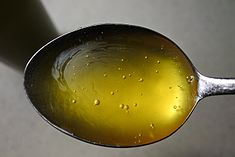Perilla oil
 | |
| Nutritional value per 100 g (3.5 oz) | |
|---|---|
| Energy | 884 kcal (3,700 kJ) |
100 g | |
| Saturated | 6-10 g |
| Monounsaturated | 12-22 g |
| Polyunsaturated | 65-86 g 52-64 g 14 g |
| †Percentages estimated usingUS recommendationsfor adults,[1]except for potassium, which is estimated based on expert recommendation fromthe National Academies.[2] | |
Perilla oil(Korean:들기름;RR:Deulgireum) is an edible vegetable oil derived fromperillaseeds. Having a distinct nutty aroma and taste, the oil pressed from the toasted perilla seeds is used as a flavor enhancer, condiment, and cooking oil inKorean cuisine.[3]The oil pressed from untoasted perilla seeds is used for non-culinary purposes.[3]
Production[edit]

Perilla oil is obtained by pressing the seeds of perilla, which contains 38-45%lipids.[4][5][6]
Nutrition[edit]
Perilla oil is considered a rich source offatty acids,and contains bothsaturatedandunsaturatedfatty acids.Saturatedfatty acidsin perilla oil are mainlypalmitic(5-7%) andstearic(1-3%).Monounsaturatedfatty acids in perilla oil areoleic(12-22%), whilepolyunsaturatedfatty acids in perilla oil arelinoleic(13-20%),gamma-linolenic(0-1%),alpha-linolenic(54-64%), andarachidic(0-1%).
In comparison to other plant oils, perilla oil exhibits one of the highest proportion ofomega-3 fatty acids,which is between 54 and 64%.[7]Theomega-6 fatty acidcomponent is usually around 14%.[8][9]
Use[edit]
Culinary[edit]

InKorean cuisine,perilla oil and sesame oil are the two chief oils used in flavoring, sauces, and dips.[10]Usually made from toasted perilla seeds, the oil is used as a flavor enhancer, condiment, and cooking oil. Either sesame or perilla oil can be used for flavoringnamul(vegetable side dishes) and other sides, pan-fryingjeon(pan-fried dishes), coatinggim(laver) before roasting it, and forming the flavor base fordipping sauce.Specifically, perilla oil is more common in thesouthern part of Koreaas perilla is cultivated more easily in the warmer areas.[10]Nowadays, perilla oil is used inKorean-style western foodas well. AMichelin-starred restaurant in Seoul serves nuttyvanilla ice creamwhich has perilla oil as its "secret ingredient."[11]
Industrial[edit]
Perilla oil made from untoasted seeds can be used for non-culinary purposes, including in paint, varnish, printing ink and linoleum.[7]As adrying oilsimilar totung oilorlinseed oil,perilla oil has been used forpaints,varnishes,linoleum,printing ink,lacquers,and for protectivewaterproof coatingson cloth. Perilla oil can also be used for fuel. It is used along with synthetic resins in the production of varnishes. It dries faster thanlinseed oiland on drying forms a film that is harder[citation needed]and yellows more than that formed by linseed oil. The paint and varnish industry accounts for the largest usage. Perilla oil is also important in the manufacture of printing inks and linoleum, and in more ancient times was a critical component in creating durableearthen floors.
In Japan, perilla oil was important for fueling oil lamps until early 16th century, before it was overtaken byrapeseedoil.[12]The oilseed containsdrying oilelements and was imported in bulk as a substitute for linseed oil into the United States from Japan, until the supply was interrupted by war.[13]
In Korea, perilla oil pressed from the untoasted seeds were used to fuel lamps and to oil floor papers.[3]
Use of press cake[edit]
Thepress cakeremaining after pressing perilla oil can be used as naturalfertilizeroranimal feed.[14]
Safety[edit]
Perilla oil is categorized as Hazard Grade III of Class 4 Hazardous Substances, by Presidential Order 33005 of Act On The Safety Control Of Hazardous Substances of the Republic of Korea. It is mainly due to its high iodine value (over 130), thus having a small probability of spontaneous combustion.[15]
References[edit]
- ^United States Food and Drug Administration(2024)."Daily Value on the Nutrition and Supplement Facts Labels".FDA.Archivedfrom the original on 2024-03-27.Retrieved2024-03-28.
- ^National Academies of Sciences, Engineering, and Medicine; Health and Medicine Division; Food and Nutrition Board; Committee to Review the Dietary Reference Intakes for Sodium and Potassium (2019). Oria, Maria; Harrison, Meghan; Stallings, Virginia A. (eds.).Dietary Reference Intakes for Sodium and Potassium.The National Academies Collection: Reports funded by National Institutes of Health. Washington, DC: National Academies Press (US).ISBN978-0-309-48834-1.PMID30844154.Archivedfrom the original on 2024-05-09.Retrieved2024-06-21.
- ^abc"deulgireum"들기름.Standard Korean Language Dictionary(in Korean).National Institute of Korean Language.Retrieved16 December2016.
- ^Shin, Hyo-Sun (1997)."Lipid Composition and Nutritional and Physiological Roles of Perilla Seed and its Oil".In Yu, He-ci; Kosuna, Kenichi; Haga, Megumi (eds.).Perilla: The Genus Perilla.London:CRC Press.p. 93.ISBN9789057021718.
- ^Sonntag, N. O. V. (1979). "Fat splitting".Journal of the American Oil Chemists' Society.56(11): 729A–732A.doi:10.1007/BF02667430.S2CID189772194.
- ^Vaughan, John G. (1970).The Structure and Utilization of Oil Seeds.London:Chapman and Hall.pp.120–121.ISBN9780412097904.
- ^abVaughan, John G.; Geissler, Catherine A. (2009).The New Oxford Book of Food Plants(PDF)(2nd ed.). New York:Oxford University Press.p. 157.ISBN978-0-19-954946-7.Archived from the original on 2016-12-20.Retrieved2016-12-04.
{{cite book}}:CS1 maint: unfit URL (link) - ^Asif, Mohammad (2011)."Health effects of omega-3,6,9 fatty acids: Perilla frutescens is a good example of plant oils".Oriental Pharmacy & Experimental Medicine.11(1): 51–59.doi:10.1007/s13596-011-0002-x.PMC3167467.PMID21909287.
- ^Lands, William E. M. (2005).Fish, Omega-3 and Human Health(PDF)(2nd ed.). Champaign, IL:AOCS Press.ISBN978-1-893997-81-3.
- ^abPettid, Michael J. (2008).Korean Cuisine: An Illustrated History.London:Reaktion Books.p. 45.ISBN978-1-86189-348-2.
- ^글 쓰는 가지 (30 November 2016)."요리사는 예술을 내놓고 식객은 충격에 휩싸인다".Maeil Business Newspaper(in Korean).Retrieved5 December2016.
- ^Gay, Suzanne (2009)."The Lamp-Oil Merchants of Iwashimizu Shrine: Transregional Commerce in Medieval Japan".Monumenta Nipponica.64(1): 1–52.doi:10.1353/mni.0.0057.S2CID201773949.
- ^Brenner, David M. (1993)."Perilla: Botany, Uses and Genetic Resources".In J., Janick; Simon, J. E. (eds.).New crops.New York:John Wiley & Sons.pp.322–328.ISBN978-0-471-59374-4.
- ^"deulkkaenmuk"들깻묵.Standard Korean Language Dictionary(in Korean).National Institute of Korean Language.Retrieved6 December2016.
- ^Presidential Order 33005 of Act On The Safety Control Of Hazardous Substances of the Republic of Korea

